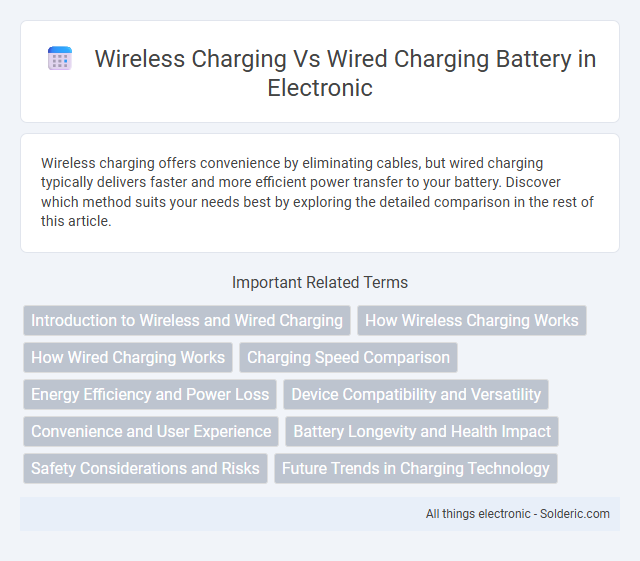Wireless charging offers convenience by eliminating cables, but wired charging typically delivers faster and more efficient power transfer to your battery. Discover which method suits your needs best by exploring the detailed comparison in the rest of this article.
Comparison Table
| Feature | Wireless Charging | Wired Charging |
|---|---|---|
| Charging Speed | Slower, typically 5W to 15W | Faster, ranges from 18W to 120W+ |
| Convenience | High--no cables needed, just place on pad | Medium--requires plugging in cables |
| Port Wear | No physical wear on charging port | Port can wear out over time |
| Device Compatibility | Requires Qi-certified devices | Compatible with most devices via cable |
| Heat Generation | Higher heat during charging | Lower heat, more efficient power transfer |
| Mobility During Charging | Limited--device must stay on charging pad | High--device can be used while charging |
| Cost | Higher initial cost for wireless pads | Generally lower cost cables and adapters |
Introduction to Wireless and Wired Charging
Wireless charging uses electromagnetic fields to transfer energy between a charging pad and a device without cables, relying on technologies like Qi standard for smartphone compatibility. Wired charging involves a direct physical connection through cables, providing faster and more efficient power transfer to batteries, commonly using USB-C or Lightning connectors. Both methods have distinct advantages, with wireless charging offering convenience and reduced wear on ports, while wired charging ensures higher charging speeds and energy efficiency.
How Wireless Charging Works
Wireless charging uses electromagnetic fields to transfer energy between a charging pad and your device through inductive coupling. A transmitter coil in the charging pad generates an alternating magnetic field, which induces a current in the receiver coil inside your device, converting it back into electrical energy to charge the battery. This method eliminates the need for physical connectors, offering convenience but typically charging at a slower rate compared to wired charging.
How Wired Charging Works
Wired charging transfers electrical energy directly through a cable connecting your device to a power source, ensuring faster and more efficient battery replenishment. This method uses a cable with connectors that deliver a steady current, allowing precise control over voltage and amperage to optimize battery health. Your device's charging circuit manages this flow, minimizing energy loss and heat generation compared to wireless alternatives.
Charging Speed Comparison
Wired charging typically offers faster charging speeds, with modern USB-C and Quick Charge technologies delivering up to 100W or more, enabling rapid battery replenishment within minutes. Wireless charging lags behind, commonly supporting 5W to 15W, which results in slower energy transfer and longer charging times for devices. Advances in wireless charging standards like Qi 2.0 are narrowing the gap, but wired solutions remain superior in charging speed for most smartphones and laptops.
Energy Efficiency and Power Loss
Wireless charging generally has lower energy efficiency compared to wired charging due to power loss from electromagnetic induction and heat dissipation during the energy transfer. Wired charging transfers energy directly through cables, minimizing power loss and maximizing charging speed and efficiency. Your device charges faster and more efficiently when using a wired connection, especially for high-capacity batteries requiring rapid energy transfer.
Device Compatibility and Versatility
Wireless charging offers broad device compatibility with Qi-enabled smartphones, smartwatches, and earbuds, supporting seamless power delivery without physical connections. Wired charging remains more versatile, accommodating a wider range of devices through various connectors like USB-C, Lightning, and micro-USB, enabling faster charging speeds. Device manufacturers continue enhancing wireless charging standards, but wired connections still lead in efficiency and universal support across multiple electronics.
Convenience and User Experience
Wireless charging offers enhanced convenience by eliminating the need for cables, allowing users to simply place their device on a charging pad, reducing wear on charging ports and minimizing clutter. Wired charging typically delivers faster charging speeds and greater energy efficiency, providing a reliable power source crucial for quick battery replenishment. User experience favors wireless charging for ease of use in casual settings, while wired charging remains preferred for performance-oriented scenarios requiring rapid battery recovery.
Battery Longevity and Health Impact
Wireless charging generates more heat than wired charging, which can accelerate battery degradation and reduce overall battery longevity. Wired charging typically provides a more stable and cooler power transfer, preserving the battery's health and maintaining its capacity over time. Optimizing charging speed and avoiding excessive heat exposure are crucial factors for enhancing battery lifespan regardless of the charging method used.
Safety Considerations and Risks
Wireless charging reduces the risk of electric shock and minimizes wear on charging ports, enhancing overall device safety. However, higher heat generation during wireless charging can potentially degrade battery health over time, increasing long-term risks. You should carefully consider the balance between convenience and maintaining optimal battery safety when choosing between wireless and wired charging options.
Future Trends in Charging Technology
Wireless charging is rapidly evolving with advancements like magnetic resonance and flexible charging pads, enabling faster and more efficient energy transfer across greater distances. Wired charging technology continues to improve through higher wattage power delivery standards such as USB Power Delivery 3.1, allowing ultra-fast charging speeds above 240W for devices and electric vehicles. Future trends indicate increased integration of wireless charging into public infrastructure and smart environments, alongside the development of hybrid systems combining wired and wireless methods to optimize battery health and charging efficiency.
Wireless charging vs Wired charging battery Infographic

 solderic.com
solderic.com